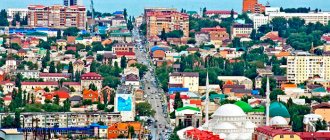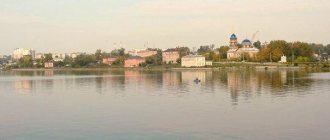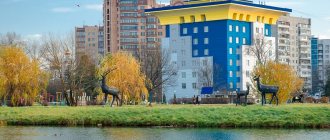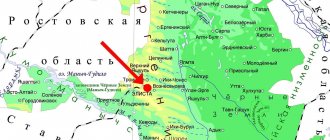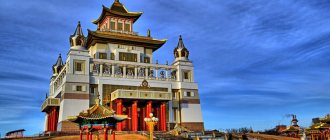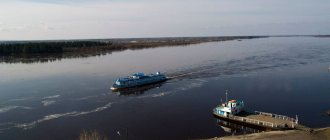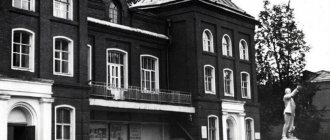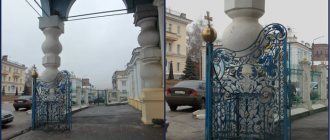Share with family and friends:
Sarov is a mysterious and, one might say, unique city. This is a place where faith and science closely coexist, and not just coexist, but conduct dialogue and help each other. It is unlikely that those representatives of the Soviet government who in the 20th century decided to create a scientific nuclear center on the ruins of a destroyed monastery thought about such an outcome. But many decades later, not only churches were reopened in Sarov. It so happened that nuclear physicists began to venerate St. Seraphim of Sarov as their heavenly patron. But the road to this was long.
History of the Sarov Desert
In the very south of the Nizhny Novgorod region, at the confluence of the two rivers Sarovka and Satis, monks began to settle in the desert area in the 17th century. They led a solitary and laborious life, dug caves and prayed to God. But truly monastic life here arose in 1706, when monk John founded the Sarov Hermitage. Then the construction of temples, residential and office premises began.
But the Sarov hermitage gained great fame thanks to the prayerful feat of St. Seraphim of Sarov. Even during his lifetime, people came to the wondrous old man for advice, told about their difficult life circumstances, and asked for prayers. The secret pilgrimage did not stop even after the death of the priest. People visited his grave and still asked for prayers.
Natural monuments
Sarov has magnificent unique natural monuments, which in 1999 received regional significance. In a deep mixed forest, in a round clearing overgrown with grass, there is the Holy Tract of Keremet - a cult place of Finno-Ugric tribes. On the bank of Satis in a deciduous forest is another attraction of Sarov - eight cold, pleasant taste and low mineralization, pure springs called Silver Keys. The natural urban landscape near the monastery includes a local natural monument in the Satis floodplain - the Flood Meadow, densely overgrown with herbs and primroses. The Sysovsky cordon and Filippovka tracts, surrounded by mixed forests and ponds formed by monks on the streams flowing here for timber rafting, are of water conservation and historical importance. The monastery ponds Varlamovsky, Protyazhka and Shilokshansky pond, visited by tourists and pilgrims, were used for the same purpose.
Trip to Sarov to see Seraphim of Sarov
In 1903, the Monk Seraphim of Sarov was canonized, and a huge number of people gathered for the solemn glorification. Tsar Nicholas II himself arrived with his entire family.
These celebrations were then written about in newspapers, publishing recollections of eyewitnesses of the events, reflections of writers and persons close to the Tsar. A trip to Sarov to see Seraphim of Sarov became one of the most popular pilgrimages of that period. And this was not dictated by fashion. The fact is that St. Seraphim of Sarov was revered by the people for his simplicity and kindness, for his Easter greetings and sincere holiness of his soul. That is why they sought his relics from all provinces.
The pilgrimage to the Sarov Hermitage was inextricably linked with Diveyevo. And because it was the last large settlement before Sarov, and because Father Seraphim himself commanded to visit the Diveyevo monastery. Stay there for at least a day, pray on the Holy Kanavka and help the Diveyevo sisters.
The Monk Seraphim of Sarov loved Diveevo. He also said in his prophetic stories that his relics would rest there, which caused bewilderment among many. But these words came true exactly at the end of the 20th century.
When the relics of St. Seraphim of Sarov were found, the question arose of where they would rest. Their return to the Sarov monastery was impossible. Because at that time it was in ruins, and the city itself had the status of a closed scientific center. It was then that they remembered the Diveyevo Monastery, where the relics of the popularly beloved saint were transferred in 1991.
We also read how and what to go to Diveevo
Parks and monuments, streets
Sarov silver keys
Address: Nizhny Novgorod region, Sarov, Serebryanye Klyuchi road GPS coordinates: N 54° 55′ 45.9984″ E 43° 24′ 48.9996″
The Sarov Silver Springs are located in a picturesque natural monastery - near the bank of the Satis River. The area is surrounded by virgin forest, consisting mainly of deciduous trees.
The keys are under government protection and are recognized as a natural monument.
The springs are a variety of springs, varying in size and connected to each other. Next to them there is a well with supposedly boiling water. This is due to the fact that the force with which the springs flow from the ground is so great that as a result, sand rises from the bottom, disturbing the water and creating a seething effect.
The springs are constantly visited by pilgrims and people who want to improve their health and heal ailments.
The water in the Sarov Silver Springs is considered healing, and this belief has a completely scientific basis. The fact is that the water was repeatedly subjected to various studies, including physical and chemical indicators. The best domestic and foreign biologists took part in the analyzes - not a single experiment revealed any contaminants in the water, which fully confirms its healing properties.
In 1989, the Sarov Silver Keys were consecrated by the Archbishop of Nizhny Novgorod.
The area named after V. I. Lenina
Address: Lenin Square
The square is located in the very center of Sarov. Every important city event takes place here, be it a Victory Day parade or a festival of folk craftsmen.
The square itself is surrounded by Soviet-era buildings: residential buildings, the House of Culture, and the city administration. And it ends with a park ensemble with fountains lined up in a row.
The sculpture of V.I. Lenin, located on the square, is recognized as one of the main architectural monuments of Sarov. It was installed on November 3, 1957, and the creator of the monument was the chief city architect N.V. Kuznetsov.
Lake Borovoe
Address: st. Embankment
The reservoir was created artificially in 1975, and was popularly called the city “Pool”.
After work to clean the pond from pollution, mass swimming and fishing are again allowed in it.
The lake regularly hosts festivals and fishing championships, various quizzes and competitions, as well as master classes for beginners and experienced fishermen.
Why is Sarov a closed city?
With the advent of Soviet power, the Sarov Hermitage did not escape the fate of many Russian monasteries and was destroyed. And in 1946, when the need for nuclear research and the threat to security for the country became urgent, Design Bureau No. 11 was located on the site of the former monastery. This is how the Soviet atomic project was born. The best scientists and promising students were brought to the city from all over the country; Andrei Dmitrievich Sakharov also worked here.
The city grew, developed, had excellent infrastructure, but it did not have a name and its location was not indicated on any map. And the residents had to be content with encrypted names - Arzamas -16, Kremlev, (and others).
At the end of the 90s of the 20th century, Sarov was returned to its historical name. After the ceremonial events on the occasion of the centenary of the glorification of St. Seraphim of Sarov, churches began to be restored, and a monastery opened in 2006.
Sarov's secrecy has been lifted, but it still remains a closed city. And there is a good reason - the scientific nuclear center must be safe.
Crime
In Soviet times, there was no crime in Sarov, or rather Arzamas-16. And we can assume that in general. The reason for this was not so much the general level of culture of the townspeople of a small scientific town, but the principle of work of law enforcement and other safety and correctional departments. Everything was very simple - if you received a criminal record, even a small one, and served your sentence, your way back to the city was closed. Such people either moved to other places or settled around the area. A mini-village at the entrance to the city is Tsyganovka. Those who are not allowed back because of a stolen wallet or, say, a fight while drunk, live out their lives there.
After perestroika, easing began, and former prisoners of various stripes began to return to their permanent residence. Despite this, the crime level in the city is much lower than ordinary cities. Sarov is still a closed city. The main recommendations for visitors are not to walk through the central park at night in the summer and in the evenings try to stay away from the hot spot located in the very center of the city - the Rowan Cafe.
There are burglaries, but they are not widespread. Many apartments in the city still have ordinary wooden doors. True, in new buildings they install iron right away.
Bicycles are fastened at shops, but most car owners do not even remove their DVRs and radar detectors at night. In neighboring Nizhny Novgorod, such a careless owner has almost a 100th chance of seeing his car with a broken glass in the morning.
There are also drunkards and drug addicts in the city, but this is not widespread. It's just that with such a small population, almost everyone knows each other.
On a bus during rush hour, they may well pull out a wallet... from an open handbag hanging on their shoulder.
How to get to Sarov?
The answer is no, unless you are a high-ranking government official or a scientist who has been sent a special invitation. In all other cases, getting into the closed city is almost impossible.
Yes, there is an educational institution there, and young people from the surrounding residential villages can go there, but not everyone succeeds. Sometimes a city needs workers, and those who want to work for posted vacancies fill out serious forms. They wait for an answer for months, and it is not always positive, such a serious check is underway. Sarov keeps secrets and does not allow everyone into its territory.
Regular people, tourists and travelers are not allowed to enter Sarov. But there is no need to be upset. Almost all the shrines that were once located in the Sarov Hermitage and associated with the name of St. Seraphim of Sarov, including the relics of the saint themselves, are located in Diveevo. And Diveevo itself is the fourth inheritance of the Mother of God. The entire Orthodox world strives here for pilgrimage.
And yet, many people really want to know what is in the closed city of Sarov. We will try to talk a little about this.
City infrastructure
There are few big streets in the city, Silkina, Lenina, Muzrukova, Kurchatova, Moskovskaya, Mira Ave. The rest are small and filled to capacity with cars. Traffic jams in the morning. In the evening too. True, for residents of big cities they will seem frivolous.
One of the main streets of the city next to the main shopping mall. Time 7 pm, weekday
There are a lot of cars in the city, a lot, a lot, a lot. In terms of the number of cars per capita, the small provincial town is on par with the Russian capital. At the same time, literally in recent years, the average price of cars standing in many yards has exceeded several million rubles and continues to grow: Infinity, Q7, the latest models of Discovery and Volvo, Cayenne - this is normal. By the way, under certain circumstances, you can ride in a taxi for 100 rubles, say, in a brand new 6th Mazda, the owner of which is kicking ass due to lack of money. This is the norm.
In the summer there are a lot of motorcyclists in the city, given the short distances and small number of roads, they often create real problems.
There are not enough parking spaces, cars are parked everywhere. The correct fashion from big cities, placing a piece of paper with a phone number under the windshield, did not reach Sarov or simply did not take root.
Public transport in the form of buses and regular minibuses runs regularly. True, in a city that can be crossed at a brisk pace in 1 hour, this is only relevant when you are too lazy to walk.
There are a huge number of taxi companies in the city, but if you need to get somewhere quickly, it is recommended to order a taxi well in advance. If you are lucky and they don’t forget about you, there is a very high probability that you will not even be late.
Those. When the girl operator says, “The car will be there in 10 minutes,” you can safely call and wait for the machine to ring, which in a metallic voice will say, “The car is waiting for you at the entrance.” Rest assured, in our case this will happen in 20, at best 15 minutes. By the way, such carelessness is not always the case among taxi drivers. This usually happens during rush hour, holidays or some other global urban disaster. For example, the first frost after rain or in Russian “Tinsmith's Day”.
Despite the fact that motorists grumble about snow removal in winter and the quality of roads, it is enough to go to any other city to understand. The roads in Sarov are fine.
Garbage collection is regular, as far as possible in Russian realities. Again, in comparison with the nearest million-plus city, Nizhny Novgorod.
Children in Sarov are also well taken care of. Don’t listen to the townspeople - the problem is getting a place in a kindergarten or school, it’s more about showing off which school or kindergarten is cooler, and not wanting to spend an extra 10-15 minutes (I didn’t wet myself, exactly 10-15 minutes) on the road.
Orthodox churches and other attractions of Sarov
Temple of Rev. Seraphim of Sarov
The first in Russia dedicated to St. Seraphim of Sarov.
Temple in the name of the Descent of the Holy Spirit (on the Near Hermitage)
Located on the shore of Borovoe pond. Built on the site of a chapel that was located next to the source of St. Seraphim and the baths.
Temple of Rev. Anthony and Theodosius and other fathers of the Kiev-Pechersk
Underground. Located on the territory of the monastery. It has been in operation since 2006, when the minor consecration took place. On September 6, 2011, the great consecration of the temple took place by Archbishop Georgy of Nizhny Novgorod and Arzamas.
Church of Rev. Zosima and Savvaty, Solovetsky Wonderworkers
It was destroyed during the Soviet years and rebuilt. The temple is two-story; the great consecration of the temple in the lower tier took place on May 26, 2012. In the upper tier - under the dome - is the Church of the Transfiguration of the Lord, consecrated on December 21, 2012.
Gate Church in the name of St. Nicholas, Myra of Lycian Wonderworker.
Located on the second tier of the bell tower of the Holy Dormition Monastery. Restored within 1 year (2012-2013). Consecrated on December 14, 2013.
Far desert
The place where Father Seraphim lived and labored.
For the Sarov celebrations of 1903, the Far Hermitage was landscaped and a new hut was erected. After the closure of the monastery, this place was destroyed.
In the 90s of the 20th century, it was decided to restore the Far Desert. And in 2000, there was already a stone chapel with a canopy. On the centenary of the glorification of the Venerable Elder Seraphim, there were attempts to historically reconstruct the place. A wooden hut was built, a copy of the one from 1903,
Monument to St. Seraphim of Sarov
Sculptor V.M. Klykov created and erected his monument in 1991 on Dalnaya Pustynka. This picturesque place in the forest for many years served as an earthly refuge for the Monk Seraphim of Sarov.
Historical sites and museums
Sarov underground complex
Address: Mira Ave., 17 A Telephone:
The Sarov underground complex was created by monks in the late 17th - early 18th centuries. Its main founder was a young monk named John, a native of Nizhny Novgorod.
Having settled on Sarov Mountain in a small cell next to other monks, the young man began to dream of creating a quiet and deserted monastery, extraordinary in beauty and grandeur. During one of the harsh winters, there was a fire in the monks’ village, and John’s cell burned down. So, in 1692, construction began on a tiny dugout similar to the caves of the Kiev Pechersk Lavra. In the future, it became the Sarov Monastery (construction was completed only in 1709).
Each cell of the underground monastery is united with the next room by stone vaults. They are hollowed out in the rock, as in the caves of the Kiev Pechersk Lavra.
Currently, individual heating systems are installed in the underground temple, and electricity is also connected. During the time of Peter the Great, the temple was illuminated by burning torches located along the narrow and cold corridors of the dungeon.
Today, Sarov guides organize various excursions through the ancient dungeons for residents and guests of the city.
Memorial Museum-Apartment of Academician Yu. B. Khariton
Address: st. Zelenaya, 1 Telephone: Opening hours: 08:00-17:00 Mon-Fri; Sat-Sun - weekend
The furnishings of the memorial museum of Academician Yu. B. Khariton are more than modest. The apartment fully reflects the quiet and reserved character of its former owners, the Kharitonovs. The entrance to the building is a tiny path leading through the garden to a small veranda.
The museum begins with a spacious hall connecting the living room with a small room. Numerous awards of the USSR Academy of Sciences are kept there to this day. They are mainly represented by gold medals and various diplomas from Academician Khariton for outstanding discoveries in the field of nuclear physics.
Among the museum exhibits you can also find a small copy of a model of Soviet atomic and hydrogen bombs, the original of which is located in the exhibition row of the VNIIEF Nuclear Weapons Museum. As well as personal belongings of Yu. B. Khariton and memorable gifts from colleagues. Among them is a giant nut from the nuclear icebreaker "Lenin" weighing 12 kg. It was presented to the academician on his 60th birthday by a close friend, academician A.P. Alexandrov.
House of Academician A.D. Sakharov
Address: st. Academician Sakharov, 8
The building was built in 1949 and is a two-unit residential building. Therefore, you can go inside only if you make an agreement with the current residents.
It was in this wooden estate that the famous Soviet theoretical physicist A.D. Sakharov once lived. Near the house there is a small garden and a gazebo, which appeared here during the scientist’s lifetime. By the way, the street on which the building is located also bears the name of the academician.
City Museum
Address: Mira Ave., 48 Phone: Website: museum-sarov.nnov.muzkult.ru Opening hours: group day - Mon; 11:00-18:00 Tue-Thu; 10:00-17:00 Fri-Sat; Sun — closed Cost: adult — 70 rubles; children (from 7 to 18 years old) - 30 rubles
The museum was opened in 1957 in the building of a former monastery hotel, built in the first half of the 19th century. Initially, the museum was biological; it received a local history direction only at the end of 1967.
Currently, the museum has three different departments: the Museum of Folk Toys, the Art Gallery and the Museum of Local History. Each of them has its own separate address.
The most valuable exhibits of the museum's main fund are ancient Russian manuscript collections from the library collections of the Sarov Desert, as well as ancient icons and things that belonged to famous Russian physicists such as A. D. Sakharov, Yu. B. Khariton and Ya. B. Zeldovich.
The museum also has a bookstall and gift shop.
Nuclear Weapons Museum
Address: Muzrukova Ave., 10 Telephone: Website: www.vniief.ru Opening hours: 10:00-18:00 Mon-Fri; Sat-Sun - weekend
The RFNC-VNIIEF Nuclear Weapons Museum was founded in 1992. It became the first museum in Russia dedicated to the history of the creation of the domestic nuclear center.
Every year more than 10 thousand visitors from local residents and tourists from different parts of the world become guests of the museum.
The museum also hosts scientific conferences and symposiums with the participation of leading world scientists.
City Art Gallery
Address: Mira Ave., 1 Telephone: Website: vk.com/sarovartgallery Opening hours: group day - Mon; 11:00-18:00 Tue-Wed; 10:00-17:00 Thu-Fri; 14:00-20:00 Sat; 11:00-17:00 Sun Cost: adult - 100 rubles; children (from 7 to 18 years old) - 50 rubles
The gallery is located within the walls of the former city cinema "October", which was closed for reconstruction back in 1994. Every year, work on the reconstruction of the cinema was postponed indefinitely, and already in the 2000s the city government decided to create an art gallery in it.
The final completion of the reconstruction took place in 2006, when a new art gallery was opened.
For residents and tourists, poetry and art evenings with famous Russian and foreign poets, writers, artists and sculptors are held here every day.
Museum of Folk Toys
Address: Mira Ave., 31 How to get there: you can enter the museum from the side of the tower Telephone: 8 (83130) 6-64-94 Website: vk.com/club108730084 Opening hours: 11:00-18:00 Mon-Thu; 10:00-17:00 Fri; Sat-Sun - weekends Cost: adult - 40 rubles; children (from 7 to 18 years old) - 25 rubles
The museum is most popular among younger residents and guests of the city. As the museum staff themselves say, toys come to life here, each of them has its own soul.
It will be interesting for an adult to watch the making of toys and become a direct participant in the process. The museum constantly holds various master classes, proving that absolutely anyone can make a beautiful toy with their own hands.
The museum also hosts exhibitions of folk art and creative evenings with the city's best handicraft masters.
Historical sights of the country's Nuclear Shield
Sarov is known in the world as the birthplace of Soviet nuclear weapons. The scientific developments of those who lived and worked in the closed city served not only to increase the power of weapons. Scientists have done a lot to create the country’s atomic shield.
Museum RFNC-VNIIEF
One of the mysterious objects of the city is the RFNC-VNIIEF Museum. This is the country's first nuclear weapons museum. The exhibits here are samples of products that have become legends in the history of the country.
Administrative building of the Nuclear Center
This ancient red brick building is one of the unofficial symbols of the city.
Built in 1911-1914. At the moment it is an architectural monument of federal significance.
Bust of Yuli Borisovich Khariton
Installed near the House of Scientists.
This man was one of the founders of VNIIEF, and the head of the Soviet atomic bomb project.
Links[edit]
Notes[edit]
- ^ abcd Law No. 184-Z
- "26. The size of the permanent population of the Russian Federation by municipalities as of January 1, 2022". Federal State Statistics Service. Retrieved January 23, 2022.
- ^ abc Law No. 155-Z
- "On the Calculation of Time". Official Internet portal of legal information
. June 3, 2011. Retrieved January 19, 2022. - Post office. Information and computing center of OASU RPO. ( Post office
).
Search for postal service objects ( postal Search for objects
) (in Russian) - My-Phone.ru. Sarov (in Russian)
- SarovLabs. Creation of the Arzamas-16 Nuclear Center
- State Duma of the Russian Federation. Federal Law No. 145-FZ of August 14, 1995 “On the renaming of the city of Kremlin, Nizhny Novgorod region, into the city of Sarov.” (State Duma of the Russian Federation. Federal Law of August 14, 1995 No. 145-FZ “ On changing the name of the city of Kremlin, Nizhny Novgorod Region, to the city of Sarov
.) - "Sarov (city, Russia) - Population statistics, charts, map and location". www.citypopulation.de
. Retrieved November 23, 2022. - "Russian military outposts: Sarov, Los Alamos of Russia". Retrieved July 9, 2013.
- Sarovlabs. "Creation of the Arzamas-16 nuclear center".
- Johnston, Wm. Robert. "Arzamas-16 criticality, 19". Retrieved July 8, 2013.
- Kudrik, Igor (23 June 1997). "Arzamas-16 researcher died on June 20". Archived from the original on July 4, 2009. Retrieved July 8, 2013.
- ↑
Stone, Richard (8 January 1999).
"RUSSIA: Nuclear strongholds in danger". The science
.
The science. AAAS. 283
(5399): 158–164. DOI: 10.1126/science.283.5399.158. Retrieved July 9, 2013. - Rhianna
Jenkins, Lyn (August 8, 2010). "Russian troops dig canal around Sarov nuclear base as wildfires grow". Observer. Retrieved July 9, 013. - ^ ab "Russian nuclear engineers buried after 'Skyfall nuclear' explosion: Experts link explosion to Burevestnik nuclear-powered cruise missile that President Putin touted in March 2022". Al Jazeera. August 13, 2022. Retrieved September 11, 2022.
- ↑
Isachenkov, Vladimir (August 14, 2022).
"Mysterious rocket explosion, radiation surge in Russia raises questions". Star Advertiser
. Honolulu. Associated Press. Retrieved September 11, 2022.
Sources [edit]
- Legislative Assembly of the Nizhny Novgorod Region. Law No. 184-Z of November 16, 2005 “On the administrative-territorial structure of the Nizhny Novgorod region,” as amended. Law No. 58-Z of May 5, 2016 “On Amendments to the Law of the Nizhny Novgorod Region “On the Administrative-Territorial Structure of the Nizhny Novgorod Region””. Came into force after ten days from the date of official publication. Published: “Nizhny Novgorod News”, No. 218 (3390), November 23, 2005 (Legislative Assembly of the Nizhny Novgorod Region. Law No. 184-Z of November 16, 2005 “ On the administrative-territorial structure of the Nizhny Novgorod Region”
as amended by Law No. 58-З dated May 5, 2016 “
On amendments to the Law of Nizhny Novgorod”).
Region “On the administrative-territorial structure of the Nizhny Novgorod region” . Valid after ten days from the date of official publication.). - Legislative Assembly of the Nizhny Novgorod Region. Law No. 155-Z of December 26, 2006 “On approval of the boundaries and composition of the territory of the urban district of the city of Sarov, Nizhny Novgorod region.” Came into force after ten days from the date of official publication. Published: “Nizhny Novgorod News”, No. 2 (3654), January 10, 2007 (Legislative Assembly of the Nizhny Novgorod Region. Law of December 26, 2006 No. 155-Z “ On establishing the boundaries and territorial structure of the urban district of the city of Sarov, Nizhny Novgorod Region
.” Enters into force after ten days from the date of official publication.). - "Los Alamos and Arzamas-16: 'Sister Cities' Relationship". Los Alamos Science
.
24
: 44–47. 1996 - Yarovitsyn, Roman (2012). A city that doesn't exist
. ISBN 978-1-4716-1437-8. - Boris Zabyvaev. "Favorite City" Sarov on the Internet. [1]
- State of War by James Risen
The future of Sarov
A city where advanced technologies flourish has high potential. It is not surprising that the infrastructure and level of culture worthy of respect are developed here. But there is something more important here.
Modern Sarov is a unique example of interaction between secular science and the church. The initiator of the restoration of some shrines destroyed during the years of Soviet power was the Nuclear Center. But the Church is also open to dialogue. At the Assumption Sarov Monastery there is a spiritual and scientific center - a platform for scientific, theological, socio-political discussions. The charitable foundation of St. Seraphim of Sarov established the “Orthodox Initiative” and “Seraphim’s Teacher” competitions. For many years in a row, the foundation has held scientific and theological conferences “The Legacy of St. Seraphim of Sarov and the Future of Russia.”
There is also an Orthodox gymnasium in Sarov, where, along with general education subjects, spiritual disciplines are included in the curriculum. At the gymnasium there are clubs of various types and a theater studio “Glagol”. Education is free. Graduates receive a state diploma.
Perhaps it is the foundation of the Orthodox faith laid from childhood that will allow a new generation of scientists to grow up, free from the imaginary contradictions of science and faith. And who knows whether Sarov is destined to become the first beacon on this new path.
Tatyana Strakhova
3 comments
Sarov: what to see and where to go in the city and surrounding area
Sarov is a quiet and peaceful closed city. You can visit it only by invitation or with local registration. If you still managed to get to this place, you can start getting acquainted with its history at the local history museum. It stores about 200 original documents about the events of the city and country, as well as rich collections of archaeological, pictorial and ethnographic finds, which have no analogues in any other museum in the world.
While in Sarov, you should definitely visit the Temple of Seraphim of Sarov, the Temple of John the Baptist and the underground temple of the Kiev-Pechersk Wonderworkers. Many pilgrims from different parts of the world come here every year.
Local guides will offer newlyweds to walk along the suspension bridge. Urban legends say that the duty of every newly-made groom is to carry his young bride in his arms from one shore to the other.
Description
Sarov is a city, a closed administrative-territorial entity, a municipal entity of the Nizhny Novgorod region, located on the territory of the Nizhny Novgorod region and, mainly, the Republic of Mordovia. Science city of the Russian Federation, the founding date is June 16, 1706.
The city appeared as the Holy Dormition Sarov Hermitage, founded on June 26, 1691.
In 1946, after the secret KB-11 was located in the city, it received the status of a closed administrative-territorial entity. In the documents it was named: Base No. 112, Gorky-130, Arzamas-75, Kremlev, Arzamas-16, Moscow-300. In 1991-1995. was officially called Kremlev again, but this was not reflected in any way in the passports and birth certificates issued at that time in the city. Since 1995 - Sarov. The city was not indicated on geographical Soviet maps. On topographic maps it was designated as a populated area of Sarova. The Kremlin is indicated as a city only on the 1994 topographic map.
The name of the desert is given by the Sarovka River. Comes from the Finno-Ugric base “sara” - swamp, swampy river, widely represented in the toponymy of Mordovia and neighboring territories.
According to chronicles, in ancient times the confluence of Sarovka and Satis was inhabited by Erzya and Mishar Tatars. Even then, there was a large settlement in this place, and many trade routes intersected here.
In 1310, the fortress of Sary Kylych (Turkic, Tatar) - “Golden, yellow saber” - was founded here.
The first hermit monk to settle on Sarov Mountain was the Penza monk Theodosius, who came to the “old settlement” in 1664 and built his cell here. After living here for about six years, Theodosius decided to retire to Penza. Around this time, the monk Gerasim from the Krasnoslobodsky monastery settled on the “old settlement”. For some time, both hermits lived together, but soon Theodosius “withdrew” to Penza, and Gerasim was left alone at the “old settlement.” After living here for some time, Gerasim retired to the Krasnoslobodsky Monastery, apparently out of fear of thieves and robbers, who began to do “many dirty tricks” to him.
Soon after Father Gerasim, Hieromonk Isaac settled in the “old settlement” and became the founder of the Sarov Hermitage. Soon Isaac had associates, and he filed a petition to establish a monastic monastery in Sarov.
In 1705, Prince Kugushev, the owner of the “old settlement,” donated a plot of land between the Satis and Sarovka rivers to Father Isaac for the future monastery. In January 1706, Metropolitan of Ryazan Stefan Yavorsky granted the request to build a church on the “old settlement”. On April 28, 1706, a wooden church was founded in honor of the “Life-Giving Spring” icon of the Mother of God. On June 16, 1706, the consecration of the first temple of the Sarov monastery took place.
From 1778 to 1833, the famous Russian saint St. Seraphim of Sarov lived in the monastery. In the mid-1850s, the monastery reached its economic peak. In 1903, the monastery hosted grand celebrations on the occasion of the canonization of Seraphim of Sarov, which was attended by Emperor Nicholas II. In 1906, the Sarov Hermitage celebrated the 200th anniversary of its existence. Many guests came to celebrate the anniversary. The Sarov Hermitage has turned into a generally recognized shrine of Russia.
After the revolution of 1917, the economy of the Sarov Monastery was ruined, the shrines were desecrated. By the end of 1925, a decision was made to close it, and in March 1927, a government decision was made to liquidate the Sarov Monastery. The property, together with the buildings, was transferred to the jurisdiction of the Nizhny Novgorod department of the NKVD of the USSR.
On the basis of the monastery in 1927, a children's labor commune of factory No. 4 NKT was created. In November 1931, the labor commune was closed. After it, a correctional labor colony for teenagers and adult prisoners was organized in the village. In November 1938 it was closed.
